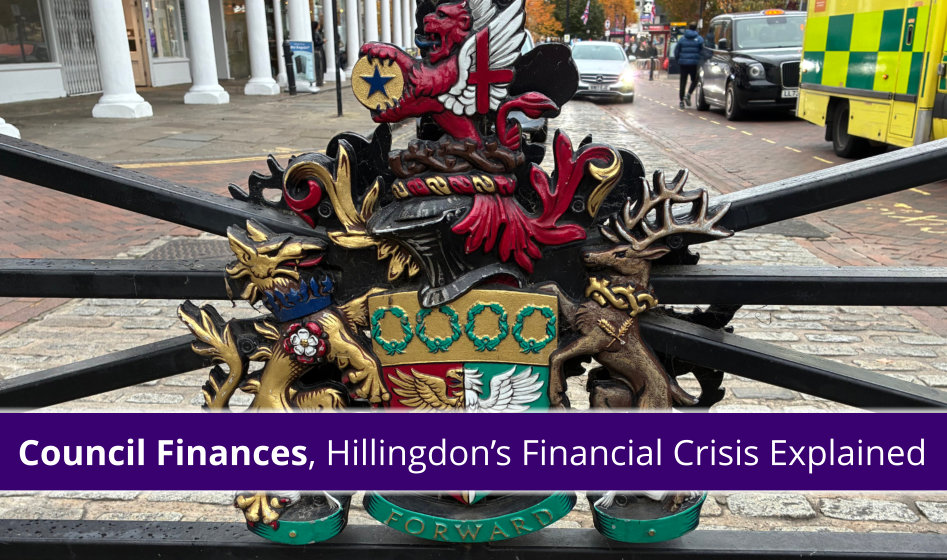
The council’s finances are in a worse state than the headline numbers suggest. The true total hit to reserves this year is £31.6 million, which will leave the council with a -£24.9 million negative reserve balance because a £14.1m ‘historical error’ left them with only £6.7 million in reserves to begin with.
Whichever of these numbers you would like to latch on to: they are all much larger than the £5m cited for ‘unreimbursed asylum costs’ and £2m for Chagossian-related costs. This crisis isn’t just due to new, unexpected costs. It is the result of a budget that the council’s own Finance Chief warned in February 2025 was “not sufficiently robust” and which external auditors have since condemned as being undermined by “poor data quality” and “systemic weaknesses”.
The Council’s Financial Crisis Explained
As residents, we are hearing a lot of large and confusing numbers about the council’s financial crisis. The two most prominent are a £30.2 million overspend and a -£24.9 million final deficit.
This article explains what these numbers mean and reveals how the council’s own headline figures don’t tell the full story.
(All figures are from the Cabinet Report, 23 October 2025 unless stated otherwise).
What is the “£30.2 Million Overspend”?
The £30.2 million is the headline figure the council uses to describe its net forecasted deficit for the current 2025/26 financial year, after applying £10.5m in contingency funds.
In simple terms, it’s the gap that has opened up between the plan (the budget set in February 2025) and the reality (the much higher amount it now expects to spend by March 2026).
The council’s report (Para 5) states the main drivers for this are:
‘Massive’ Demand Pressures (£19.5 million):
These are the day-to-day services that are costing far more than was budgeted. The main pressures are in statutory, high-need areas:
- Adult Social Care: £8.2 million overspend
- Homes and Communities (Housing/Homelessness): £6.5 million overspend
- Children and Young People’s Services: £5.1 million overspend
These are areas of spending where the budget was wrong, underestimating the sums required. How they could be so wrong and so quickly remains a question. This is spending that the council expects to make between April 2025 and March 2026, compared against what they planned to spend when they set the budget in February 2025.
This Year’s Failing Savings Plan (£8.0 million + £7.1 million)
The budget was balanced by planning to make £38.8 million in savings. As the council’s finance chief warned in February, this was a “significant risk”. That plan is now collapsing. This month’s report identifies both an £8 million shortfall in savings within the services listed above anda separate £7.1 million pressure from failing “cross-cutting” corporate savings.
These figures, combined with other pressures like unbudgeted pay awards, create the total overspend.
The “Confusing Arithmetic”: Why is the Final Deficit -£24.9 Million?
This is the most critical question, as the council’s headline numbers do not add up.
Residents have understandably asked: “If the council started with a £17.8 million ‘hole’ and then overspent by £30.2 million, shouldn’t the final deficit be -£48 million?“
The answer is the key to understanding the crisis. The £17.8 million “hole” was not a new cost this year; it was the difference between the fantasy starting point and the real one.
- The Fantasy: When the council set its budget, it thought it had £24.5 million in reserves (Chief Finance Officer’s Section 25 Statement, Feb 2025).
- The Reality: By July, it was revealed that a £14.1 million “historical error” meant the council actually only had £6.7 million (July Audit Committee / Cabinet Report, October).
The real financial calculation for this year must start from the actual amount of money the council had at the start of April 2025.
The Arithmetic Problem:
- Actual Starting Reserves: £6.7 million
- Minus the Headline Overspend: -£30.2 million
- = -£23.5 million
This is £1.4 million less than the -£24.9 million deficit the council itself is forecasting.
(A note on this: This isn’t an error in our calculation; it’s a discrepancy in the council’s headline figures. We are simply trying to make the council’s own numbers add up. The council states it started with£6.7 million and will end with-£24.9 million. But their headline overspend of£30.2 million doesn’t bridge that gap. This means there is a “missing” £1.4 million pressure that is not included in their main headline figure.)
The Real Answer (The “Missing” £1.4m):
Buried in the details of the same report is the answer. To get to the final deficit, you must add another pressure that isn’t included in the £30.2m headline:
- A £1.4 million Drawdown from Earmarked Reserves: The report states this extra £1.4 million is being taken from other specific pots of money “primarily to support insurance claims and homelessness related pressures during this financial year” (Cabinet Report, 23 October 2025).
The Total Real Overspend is therefore £31.6 million. This is the only number that makes the council’s arithmetic work.
The Real, Real Arithmetic:
- Actual Starting Reserves (on April 1): £6.7 million
- MINUS the Total Real Overspend: -£31.6 million
- EQUALS the Final Forecasted Deficit: -£24.9 million
The fact that the council’s headline figure (£30.2m) is different from the real figure (£31.6m) that is required to make its own sums add up is a perfect example of the “poor data quality” and “systemic weaknesses” the external auditors, Ernst & Young, formally warned the council about in their July 2025 Section 24 Report.
